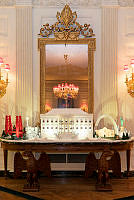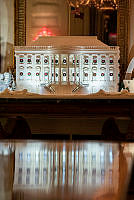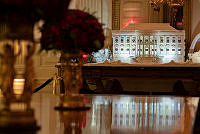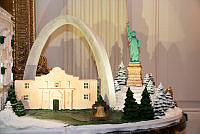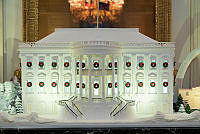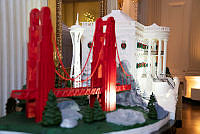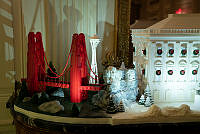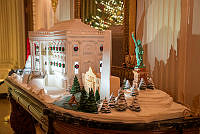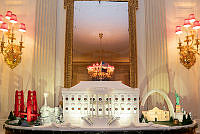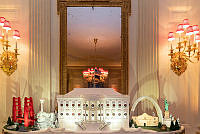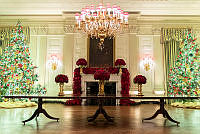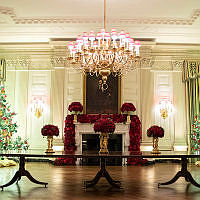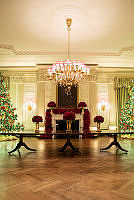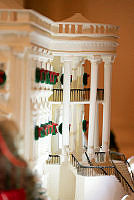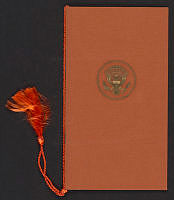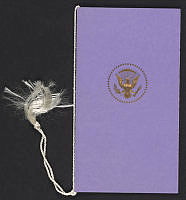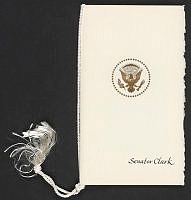The White House and Lincoln's Assassination
Copyright © Spring 2009 White House Historical Association. All rights reserved under international copyright conventions. No part of this article may be reproduced or utilized in any form or by any means, electronic or mechanical, including photocopying, recording, or by any information storage and retrieval system, without permission in writing from the publisher. Requests for reprint permissions should be addressed to books@whha.org

Abraham Lincoln had never been more William Tecumseh Sherman’s thrust through the cheerful and carefree in the White House than on his last day alive. Richmond, the Confederate capital, had recently fallen, and it was only five days since Washingtonians had celebrated the deliriously exciting news of Robert E. Lee’s surrender to the Union victor, Ulysses S. Grant. The grinding war was all but over, barring a few weeks of inconsequential skirmishes, and the president could look with confidence beyond the ghastly battlefields. The burden had been visibly telling on his prematurely aging face. With more than 600,000 Americans dead in the North and the South, Lincoln had forecast the year before, “This war is eating my life out. I have a strong impression that I shall not live to see the end.”1 Yet he had survived and was now on the threshold of leading the nation into a period of reconciliation and reconstruction. The 56-year-old father had good reason to feel buoyant when he breakfasted on Good Friday, April 14, 1865, with his oldest son, Robert, on leave from Grant’s staff, telling him they would soon live in peace “with the brave men of the South.”2 It was vintage Lincoln, displaying reason and magnanimity with an impulse to conciliate and heal.
The president was even jubilant by the time he greeted Senator John Cresswell of Maryland, who sought a pardon for an imprisoned Confederate friend. “Hello, Cresswell. The war is over!” Lincoln exulted. “It has been an awful war. But it’s over!”3 His genial mood carried over into a White House meeting of the cabinet, where he predicted invigorating news of General Carolinas. He had even resorted to comic relief during a serious discussion on how to treat leaders of the failed rebellion, suggesting it might be a good idea to turn a blind eye to any escaping across the country’s borders. “The situation reminds me of an old Irishman in Illinois,” he said, “who, having been a hard drinker, finally signed the pledge, and was living up to it until one day he went into a drug store and asked for a glass of water. The clerk, knowing his propensities, said ‘Pat, shall I put a stick in it?’ The Irishman replied, ‘Well, if you please. I’ve signed the pledge, but if you do it unbeknownst to me, it will be alright.’”4

The barouche in which President Lincoln rode to Ford’s Theatre was built by Wood Brothers of New York, from whom it was purchased by a group of Lincoln supporters and presented to him on the occasion of his first inaugural.
Picture HistoryDuring an afternoon carriage ride, Mary Todd Lincoln was taken aback by Lincoln’s “playful” nature. “Dear husband,” she observed, “you almost startle me by your great cheerfulness.” Joyfully, he responded, “And well I might feel so, Mary. I consider this day, the war has come to a close.” Recalling the death of their son, Willie, three years earlier, he reflected, “We must both be more cheerful in the future. Between the war and the loss of our darling Willie, we have both been very miserable.” 5
Lincoln arrived late at Ford’s Theatre for the comedy, Our American Cousin, but the actors joined the audience of more than 1,600 people in rousing applause for the president as the band struck up “Hail to the Chief.” The beloved chief executive, who had secured victory and preserved the Union, acknowledged the ovation and took his seat in the private box to the right, overlooking the stage 12 feet below. His wife sat beside him with their guests, Major Henry Rathbone and his fiancée, Clara Harris.
In the second scene of the third act John Wilkes Booth passed unobtrusively into the closed alcove between the dress circle audience and the door to the president’s box. He leveled the single shot Derringer pistol and fired at point blank range behind Lincoln’s left ear. The assassin warded off, then stabbed and wounded Rathbone, leaped onto the stage, screamed out the Latin motto of Virginia, “So always to tyrants,” escaped out the back door onto his waiting horse, and galloped off into the night.

The assassination of President Lincoln as illustrated in publications of the day. The Assassination of President Lincoln, a popular print sold in the 1860s for framing, probably hung in many a residence and was found in even more scrapbooks.
Library of CongressShortly afterward a frenzied man rushed into Grover’s Theatre, where the president’s youngest son, Tad, 12, was watching a performance of Aladdin; or, The Wonderful Lamp with a White House staffer. “President Lincoln has been shot at Ford’s Theatre!” he shrieked.6 When Tad got back to the White House he ran up to the assistant doorkeeper, Thomas Pendel, crying out, “Oh, Tom Pen! Tom Pen! They have killed papa dead!” They’ve killed papa dead!” Pendel, a former marine, sat by the boy’s bedside beyond midnight before sleep finally overcame the shattered child. 7
Doctor Charles Leale, the first surgeon to reach the wounded president, turned down suggestions to transport Lincoln back to the White House, intimating the bumpy road and upright position in which he would have to be positioned might quicken his death. Volunteers carried the unconscious president across the road to a boarding house, where the 6 feet 4 inch supine leader labored throughout the night, exhaling for the last time at 7:22 a.m. the following day. “Now he belongs to the ages,” said Secretary of War Edwin Stanton. 8

German-born medical illustrator Hermann Faber of Philadelphia accompanied the army Surgeon General Joseph Barnes to Lincoln’s bedside. Immediately after the body was removed to the White House, Faber made two pencil sketches of the room and the men present as the president lay dying. General Barnes and Dr. Joseph Janvier Woodward pronounced it accurate. The portrait figures developed subsequently, following Dr. Woodward’s recollection, are 1) Gideon Welles, secretary of the navy; 2) Salmon P. Chase, secretary of the treasury; 3) Robert King Stone, Lincoln’s personal physician; 4) Charles Sumner, U.S. Senator; 5) Charles Crane, assistant surgeon general; 6) Joseph Barnes, surgeon general 7) Major General Henry Halleck; and 8) Edwin M. Stanton, secretary of war.
National Museum of Health and MedicineLincoln’s body was still limp and warm when taken out of the temporary coffin and placed on a cooling board in the Prince of Wales Room, the guest suite in the White House. Named for Queen Victoria’s son and heir who had slept in it five years earlier, the west front corner room overlooked crowds of mostly black men, women, and children, weeping in the rain in a stoic vigil extending over days. Less than a week had passed since thousands of joyful freed slaves had massed to sing “The Year of Jubilee” after learning of Lee’s surrender. 9 One of their emancipated race would later lament the loss of their “Moses.”10
The lights had dimmed forever in the life of Mary Todd Lincoln. She kept to her darkened bedroom overlooking grounds at the back of the White House, crying and wailing so pitifully that even young Tad had pleaded, “Don’t cry so Mama. Don’t cry or you will make me cry, too. You will break my heart.” Only then did she stifle her tears and squeeze tight the youngest of her two surviving sons. 11

President Lincoln wore his “silk finish” felt top hat to Ford’s Theatre the night he died.
National Museum of American History, Smithsonian InstitutionMary Jane Welles, wife of the secretary of the navy, was one of a select few allowed into Mrs. Lincoln’s room in futile efforts to offer companionship and gentle comfort. Gideon Welles conferred briefly with his wife in the White House Library, then, as he walked downstairs on his way out with Attorney General James Speed, a tearful Tad turned from a window on the landing and asked, “Oh, Mr. Welles, who killed my father?” Both Welles and Speed, eminent and skilled in persuasive talk and opinion, now faltered, unable to give the boy an answer as each fought hard to blink back tears. 12
A series of mix-ups and mishaps had delayed the arrival of Mary Todd Lincoln’s closest confidante and companion, her seamstress Elizabeth Keckly, who could have provided immediate support and succor. The widow had sent messengers to summon the African American Keckly to the White House on the night of the assassination, but they had botched the instructions and got lost. Keckly had learned of the murder within an hour of the gunshot and instinctively raced to her friend at the White House, but armed guards made no exception in denying her and others entry in the night of unprecedented turmoil. When she finally entered the darkened room in the morning, Mrs. Lincoln could only murmur,
“Why did you not come to me last night, Elizabeth? I sent for you.” Keckly felt profound sympathy as she rested her hand on the feverish brow of her friend, who would in time be committed to a sanitarium. 13d suffered a similar loss, she wrote to the widow Queen Victoria, “can appreciate the intense grief I now endure.” 24

Lincoln’s body was moved to the White House, where an autopsy was performed in the Prince of Wales Room by doctors attached to the Office of the Surgeon General. Those performing the autopsy included Joseph Barnes and Edward Curtis (fifth and sixth from the left) and Joseph Javier Woodward (far right).
National Museum of Health and MedicineThe autopsy began less than five hours after death, with Lincoln’s unclothed body covered only by sheets and towels as it lay stretched out on boards brought into the Prince of Wales Room by the embalmer. As Dr. Edward Curtis prepared to start the postmortem with Dr. Janvier Woodward, he marveled at Lincoln’s muscular form, unexpected in an elongated man who stooped.14
While the surgeons fingered the spongy brain, tracing the path of the lead ball along a line of torn tissue and congealed blood, a messenger came in from Mrs. Lincoln requesting a lock of her husband’s hair. Dr. Robert Stone, the Lincolns’ family physician, snipped some strands off the broken skull, then gave the same treasured keepsakes to each of the attending doctors.15
When Curtis got home later that day his wife cut off the bloodstained shirt cuffs for instant preservation as historic relics. With equal reverence, her husband delicately removed for personal safekeeping a splinter of Lincoln’s skull stuck to one of his surgical instruments.16

The black crape customary at presidential funerals was used abundantly for Lincoln, wrapping columns as seen on the Capitol (above) and Treasury Department Building (below), draped from windows and doorways, and visible also in black armbands worn by men and black scarves and ribbons for women.
John Richter Collection
Black mourning material quickly appeared all over the capital, hanging as sheets or stretched in folds across the face of the White House and many homes, offices, hotels, shops, and places of business. The traditional outward sign of grief wound around columns and pillars of government buildings and dropped limply from roofs and windows. Black mourning cloth bordered oversize mirrors in the East Room of the White House in readiness for the arrival of invitees bearing black-bordered admission cards to the funeral service. Lincoln’s principal private secretary, George Nicolay, arrived back from a visit to Charleston two days after the president’s death to find the White House “dark and still as almost the grave itself.” 17
The following day a front gate admitted thousands of Washingtonians and others who had lined up for hours to pay their last respects before the mahogany coffin. The embalmer, Henry Cattell, had shaved off Lincoln’s beard, leaving only a tuft of hair on the chin. The tallest president lay solid as marble in a 6 feet 6 inch coffin bearing the simple wording etched into a silver plate:
Abraham Lincoln
16th President of the United States
Born February 12th 1809 Died April 15th 1865(18)
One woman who had waited steadfastly in line while it rained, wrote, “We were not permitted to wait a moment near the corpse, so it was impossible to obtain a satisfactory view.” 19 But she had at least come close to the object of her devotion, an honor denied “tens of thousands” of others turned away when guards closed the gate for the day. 20

This black-bordered card admitted one person on a very restricted list to Lincoln’s funeral in the East Room. White House stationery and that of the upper officials of the government were reprinted with the black border and used for thirty days following Lincoln’s death.
Chicago History MuseumAs dignitaries crammed into the spacious East Room for the funeral service four days after Lincoln’s death, Mrs. Lincoln remained reclusive upstairs, unresponsive to the solicitude of others and weakened by lack of sleep and loss of appetite, yet left alone to writhe in the harrowing isolation of her trauma and sorrow.
President Andrew Johnson stood near the long coffin resting above a raised catafalque under an ornately domed canopy. The grandeur was fitting for the passing of a president but out of character for the simple preferences of Lincoln. His ravaged remains had been cosmetically disguised for the public. The untested seventeenth president was one of the few who had seen Lincoln’s brain lifted out of the gaping skull during the cranial autopsy. Others were unaware that the jugular had been cut to drain blood out of the body and that the top of his skull had been sawn off to get at the brain. But all were aware of a historic passing, and a profound sadness filled every onlooker. Even Lieutenant General Ulysses S. Grant, inured to carnage on a scale unimaginable to those who had never walked among battlefield dead, wept openly near the coffin. His own grief was deep and immediate and in time he would write fondly of Lincoln’s “goodness of heart and his desire to have everybody happy.” 21

Crowds line the sidewalks on Pennsylvania Avenue to view President Lincoln's mile-long funeral procession from the White House to the Capitol.
Library of CongressThe Reverend Doctor Phineas Gurley extolled Lincoln’s virtues in nostalgic remembrance of a friend. “We admired his childlike simplicity, his freedom from guile and deceit,” said the Presbyterian family pastor, given the honor of leading the service in the presence of dozens of clergymen from different denominations. But he could not hide his own bafflement by the terrible turn of events. “We will wait for His interpretation,” he declared, as if fumbling for a meaningful answer and settling for unconditional faith. 22
So many delegations and individuals took part in the mile-long funeral procession to the Capitol that those in the lead reached the end before the last had even left the White House. A U.S. Army regiment of black infantrymen, included at the insistence of Secretary of War Stanton, proudly led the extended cortege.23
Forty thousand mourners filed by the casket while it lay in the Rotunda of the Capitol during fourteen hours of viewing the next day. Again the dignitaries were on hand at the train depot for a final farewell as the remains were taken across country for the funeral in Springfield, Illinois.

Upon receiving a note of sympathy from Queen Victoria, Mary Lincoln wrote the following response: “I have received the letter which Your Majesty has had the kindness to write and am deeply grateful for its expressions of tender sympathy, coming as they do from a heart which from its own Sorrow, can appreciate the intense grief I now endure. Accept, Madam, the assurances of my heartfelt thanks and believe me in the deepest sorrow, Your Majesty’s Sincere and grateful friend.”
Library of CongressBut the widow did not budge from seclusion. Five weeks would pass before she finally took leave of the White House, though encased in mournful misery until her own death seventeen years later. Only another who have suffered a similar loss, she wrote to the widow Queen Victoria, "can appreciate the intense grief I now endure." 24













